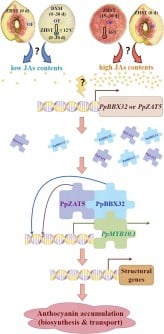Recent research has shed light on the genetic mechanisms influencing the color variation of peaches, revealing how specific genes interact with environmental factors to affect pigmentation. A collaborative team from Zhejiang University and the New Zealand Institute for Plant & Food Research identified two critical genes, PpBBX32 and PpZAT5, which play a significant role in the regulation of anthocyanin production in peaches. This study, published on July 30, 2024, in Horticulture Research, offers insights into how these genes respond to jasmonate signaling, a vital aspect of plant hormone interactions.
Anthocyanins are pigments responsible for the vibrant red, purple, and blue colors found in various fruits and vegetables. These pigments not only enhance visual appeal but also provide antioxidant benefits. In peaches, levels of anthocyanins differ significantly among cultivars, tissues, and even storage conditions. For instance, moderate cold storage can induce red coloring in the flesh of certain peach varieties, but this effect is not universally applicable.
Key Discoveries in Peach Pigmentation
The research team conducted transcriptomic analyses across different peach cultivars and conditions to understand how environmental factors influence gene expression. They found that anthocyanin accumulation in the outer flesh of the ‘Zhonghuashoutao’ cultivar occurred at precisely 16°C. This discovery highlighted the role of PpBBX32 and PpZAT5 as central regulators of the gene PpMYB10.1, which is crucial for anthocyanin biosynthesis.
Further experiments demonstrated that overexpressing either gene significantly increased anthocyanin levels in both peach and tobacco plants, while silencing them led to reduced pigment accumulation. The study also revealed that PpBBX32 and PpZAT5 form a ternary protein complex with PpMYB10.1 that amplifies the activation of genes responsible for pigment production. The expression of these genes was shown to be induced by methyl jasmonate, linking hormone levels to pigmentation across various tissues.
“This study gives us a molecular explanation for something growers and consumers have observed for years—why some peaches develop beautiful red flesh while others don’t,” said Dr. Changjie Xu, corresponding author of the study.
Dr. Xu emphasized the significance of identifying PpBBX32 and PpZAT5 as central elements responding to temperature and hormone cues. This understanding not only enhances the comprehension of fruit pigmentation but also presents opportunities for breeders aiming to improve the aesthetic and health attributes of peaches.
Implications for Peach Breeding and Storage
The findings from this research open avenues for practical applications in peach breeding and postharvest storage. By targeting the PpBBX32–PpZAT5–PpMYB10.1 regulatory module, breeders could develop peach cultivars with more vibrant and consistent red flesh, regardless of environmental conditions. Moreover, implementing postharvest treatments with jasmonate analogs or adjusting storage temperatures may activate these genetic pathways to enhance anthocyanin levels in harvested fruit.
Beyond peaches, the regulatory framework identified in this study could extend to other crops where coloration is a critical quality trait, suggesting broader implications for horticultural science and food quality enhancement.
This research was financially supported by the National Natural Science Foundation of China and the Pao Yu-Kong International Fund, among others. The findings contribute to the ongoing exploration of plant genetics and their applications in agriculture.
